Voronezh
| Voronezh (English) Воронеж (Russian) |
|
|---|---|
| — Inhabited locality — | |
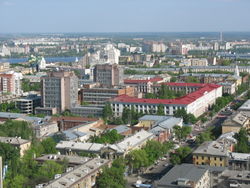 View of Voronezh |
|
.svg.png) Location of Voronezh Oblast in Russia |
|
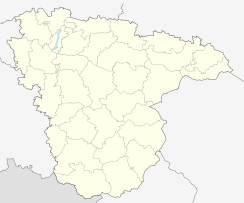 Location of Voronezh in Voronezh Oblast
|
|
| Coordinates: | |
 Coat of arms |
 Flag |
| Holiday | Second Sunday of September[1] |
| Administrative status | |
| Country | Russia |
| Federal subject | Voronezh Oblast |
| Administrative center of | Voronezh Oblast[1] |
| Municipal status (as of June 2008) | |
| Urban okrug | Voronezh City[1] |
| Head[1] | Sergey Koliukh[2] |
| Representative body | City Duma[1] |
| Statistics | |
| Area | 590.43 km2 (227.97 sq mi) |
| Population (2002 Census) | 848,752 inhabitants[3] |
| - Rank | 16th |
| - Density | 1,438 /km2 (3,720 /sq mi)[4] |
| Time zone | MSK/MSD (UTC+3/+4) |
| Founded | 1585 or 1586[1][5] |
| Postal code(s) | 3940xx[6] |
| Dialing code(s) | +7 4732[7] |
| [www.voronezh-city.ru Official website] | |
Voronezh (Russian: Воро́неж [vɐˈronʲɪʂ]) is a large city in southwestern Russia, not far from Ukraine. It is located either side of the Voronezh River, twelve kilometers away from where it flows into the Don. Voronezh is the administrative center of Voronezh Oblast. It is an operating center of the Southeastern Railway (connecting European Russia with Ural and Siberia, as well as Caucasus and Ukraine), as well as the center of the Don Highway (Moscow—Rostov-on-Don). Population: 848,752 (2002 Census);[3] 886,844 (1989 Census);[8] 660,000 (1970); 447,000 (1959); 344,000 (1939); 120,000 (1926). The city is divided into six administrative districts: Kominternovsky, Leninsky, Levoberezhny, Sovetsky, Tsentralny, and Zheleznodorozhny.
Contents |
History
The Voronezh River was first mentioned in the Hypatian Codex under 1177, but human settlement on the site is attested since the Stone Age. The present town was founded in 1585 or 1586 by Feodor I as a fort protecting the Russian state from the raids of Crimean and Nogay Tatars.
In the 17th century, Voronezh gradually evolved into a sizeable town, especially after Tsar Peter the Great built a dockyard in Voronezh, where the Azov Flotilla was constructed for the Azov campaigns in 1695 and 1696. This fleet, the first ever built in Russia, included the first Russian ship of the line, Goto Predestinatsia.
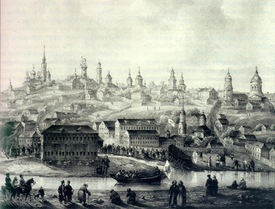
Owing to the Voronezh Admiralty Wharf, Voronezh became, for a short time, the largest city of Southern Russia and the economic centre of a large and fertile region. In 1711 it was made the administrative centre of the Azov Province, which morphed into the Voronezh guberniya (known as namestnichestvo in 1779-1824).
In the 19th century Voronezh was a centre of the Central Black Earth Region. Manufacturing industry (mills, tallow-melting, butter-making, soap, leather and other works) as well as bread, cattle, suet, and the hair trade developed in the town. A railway connected Voronezh with Rostov-on-Don in 1868 and Moscow in 1871.
During World War II, Voronezh was the scene of fierce fighting between Russian and combined Axis troops. It was used by the Germans as a staging area for the attack on Stalingrad, and a key Don River crossing point.
In September 1989, there were famous UFO sightings in Voronezh, which drew attention from the press and TV. There were also reports on two strange creatures that came out of the UFO after it landed in a park.
Between 1991 and 2000 the city, high in unemployment, became a part of the Communist-voting region known as Russia's Red Belt. Today Voronezh is the economic, industrial, cultural, and scientific center of the so-called Black Earth Region. There are 7 theaters, 12 cinemas in the city; it is also home to Voronezh State University.
The city's large student population includes many foreigners as foreign students in Russia usually take one year of Russian language in Voronezh before moving on to universities elsewhere. This has led in the past to tension between foreign students and the indigenous population, resulting in a number of murders, the last one of Peruvian student Enrique Anhelis Hurtado on October 9, 2005. There were 45 reported attacks on foreigners in Voronezh in that year.
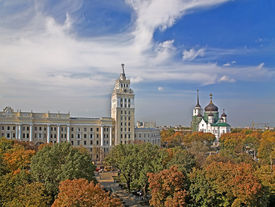
Many famous people were born and lived in Voronezh and the surrounding area. Among them are Nobel-prize winning physicist, inventor of laser Nikolay Basov; poets and writers such as Platonov, Bunin, Koltsov, Nikitin, Marshak, Peskov, Troepolsky; painters Kramskoi, Ge, Kuprin, Vikentii Trofimov, the physicist Cherenkov; navigator and polar explorer Valerian Albanov of ill-fated Arctic ship St. Anna; chess player Grigory Sanakoev; gymnasts Davydova, Tkachyov; the anarchist Voline, and the surgeon Serge Voronoff. The Russian poet Osip Mandelstam was exiled to Voronezh after his arrest in 1934 and wrote a series of poems there collected under the title "Voronezh Notebooks". The Russian punk band Sektor Gaza was founded in Voronezh.
After 2 seasons without a professional football team the Fakel Voronezh franchise was restored for the 2010 season and currently competes in the Russian regional leagues (equivalent to the English League 1)
Not far from Voronezh is the satellite town of Novovoronezh ("New Voronezh") which serves a local nuclear power plant. Both cities are served by Chertovitskoye Airport which is the home of Polet Airlines. Voronezh is also home to Voronezh Pridacha airport, part of a major aircraft manufacturing facility, VASO - Voronezhskoye Aktsionernoye Samoletostroitelnoe Obshestvo (Voronezh aircraft production association) where the Concordski, Tupolev Tu-144, was built and the only operational one is still stored. Voronezh also hosts Voronezh Malshevo air force base in the south-west of the city, which, according to a Natural Resources Defense Council report, apparently houses nuclear bombers.
Further reading
Charlotte Hobson's book, "Black Earth City", is an account of life in Voronezh at the time of the fall of the Soviet Union based on her experiences after spending a year in Voronezh as a foreign student in 1991–1992.
Nadezhda Mandelstam's Hope Against Hope, the first volume of her memoirs concerning her husband, the poet Osip Mandelstam, provides many details about life in Voronezh in the 1930s under Stalinist rule.
From the mid-nineteenth century is the diary of a British soldier, a sergeant in the Royal Welch Fusiliers, published as "Prisoners of Voronesh (sic)". George Newman was captured in the Crimean War and then marched under a loose guard with a motley crew of PoWs, convicts, etc., to Voronezh.
Urbanization
Voronezh city has been completely urbanized in the last 3 years, The city has 20 nightclubs, more than 100 shopping malls, 5,000 citybuses, and an International Airport.
Transport
Air transport
Chertovitskoye International Airport with IATA airport code VOZ, is located north of the city. It has a single runway 2300 metres long. There are regular flights to Moscow with a flight time of about 1 hour.
Regular flights to: Antalya, Baku, Istanbul, Kiev, Milan, Minsk, Munich, Prague, Tel-Aviv and Yerevan.
Rail transport
Rail services form part of the Southeastern Railway of RZD (Russian Federal Railways). There are regular express trains to Moscow that take about 10 hours. Other destinations served direct from Voronezh include K'yiv, Kursk, Novorossiysk, Sochi and Tambov.
Local transport
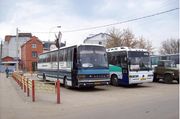
Buses and minibuses provide the bulk of local public transport. There are some trolleybuses but the system has been allowed to degrade. The once extensive tramway network was finally abandoned on 15 April 2009.[9]
Education in Voronezh
- Voronezh State University
- Voronezh State Technical University
- Voronezh State Pedagogical University
- Voronezh State Agricultural University
- Voronezh State Technological Academy
- Voronezh State Medical Academy
There are 2000 schools within the city.
Climate
| Voronezh | ||||||||||||||||||||||||||||||||||||||||||||||||||||||||||||
|---|---|---|---|---|---|---|---|---|---|---|---|---|---|---|---|---|---|---|---|---|---|---|---|---|---|---|---|---|---|---|---|---|---|---|---|---|---|---|---|---|---|---|---|---|---|---|---|---|---|---|---|---|---|---|---|---|---|---|---|---|
| Climate chart () | ||||||||||||||||||||||||||||||||||||||||||||||||||||||||||||
|
||||||||||||||||||||||||||||||||||||||||||||||||||||||||||||
|
||||||||||||||||||||||||||||||||||||||||||||||||||||||||||||
International relations
| Date | Sister City | |
|---|---|---|
| 1968 | Brno, Czech Republic[10] | |
| 1989 | Wesermarsch, Lower Saxony, Germany | |
| 1991 | Charlotte, North Carolina, United States | |
| 1992 | Chongqing, People's Republic of China | |
| 1995 | Sliven, Bulgaria | |
| 1996 | León, Castile and León, Spain[11] |
References
- ↑ 1.0 1.1 1.2 1.3 1.4 1.5 http://www.voronezh-city.ru/mat/post/ustav_gogv.doc
- ↑ http://www.voronezh-city.ru/index.php?r=gov&d=9189
- ↑ 3.0 3.1 Федеральная служба государственной статистики (Federal State Statistics Service) (2004-05-21). "Численность населения России, субъектов Российской Федерации в составе федеральных округов, районов, городских поселений, сельских населённых пунктов – районных центров и сельских населённых пунктов с населением 3 тысячи и более человек (Population of Russia, its federal districts, federal subjects, districts, urban localities, rural localities—administrative centers, and rural localities with population of over 3,000)" (in Russian). Всероссийская перепись населения 2002 года (All-Russia Population Census of 2002). Federal State Statistics Service. http://perepis2002.ru/ct/html/TOM_01_04_1.htm. Retrieved 2009-08-19.
- ↑ The value of density was calculated automatically by dividing the 2002 Census population by the area specified in the infobox. Please note that this value may not be accurate as the area specified in the infobox does not necessarily correspond to the area of the entity proper or is reported for the same year as the Census (2002).
- ↑ "Историческая хроника (Historical chronicle)" (in Russian) (DOC). Муниципальное учреждение культуры Централизованная библиотечная система города Воронежа Центральная городская библиотека имени А. Платонова (Municipal Cultural Centralized Library System of the Voronezh City A. Platonov Central City Library). 2009. http://www.voronezh-city.ru/mat/history.doc. Retrieved 25 September 2009.
- ↑ http://www.e-adres.ru/postcodes/3800347/
- ↑ http://www.rt.ru/help-info/mg/index.php?SELECTED_CHAR=В
- ↑ "Всесоюзная перепись населения 1989 г. Численность наличного населения союзных и автономных республик, автономных областей и округов, краёв, областей, районов, городских поселений и сёл-райцентров. (All Union Population Census of 1989. Present population of union and autonomous republics, autonomous oblasts and okrugs, krais, oblasts, districts, urban settlements, and villages serving as district administrative centers.)" (in Russian). Всесоюзная перепись населения 1989 года (All-Union Population Census of 1989). Demoscope Weekly (website of the Institute of Demographics of the State University—Higher School of Economics. 1989. http://demoscope.ru/weekly/ssp/rus89_reg.php. Retrieved 2007-12-13.
- ↑ Buses Worldwide ISSN 0961-2122, issue 161, July 2009
- ↑ "Brno - Partnerská města" (in Czech). © 2006–2009 City of Brno. http://www.brno.cz/index.php?nav02=1985&nav01=34&nav03=1010&nav04=1016&nav05=1249&nav06=1272. Retrieved 2009-07-17.
- ↑ http://www.larazon.es/noticia/ciudades-y-pueblos-se-benefician-del-hermanamiento-con-otros-territorios
External links
- Voronezh State University - City page
- Voronezh.Net City site (Russian)
- Voronezh City Аdvertising (Russian)
- Voronezh News (Russian)
- Big Voronezh forum "U Antona" (Russian)
- Voronezh city churches (English)
- Site about old Voronezh (English)
|
||||||||||||||
|
|||||